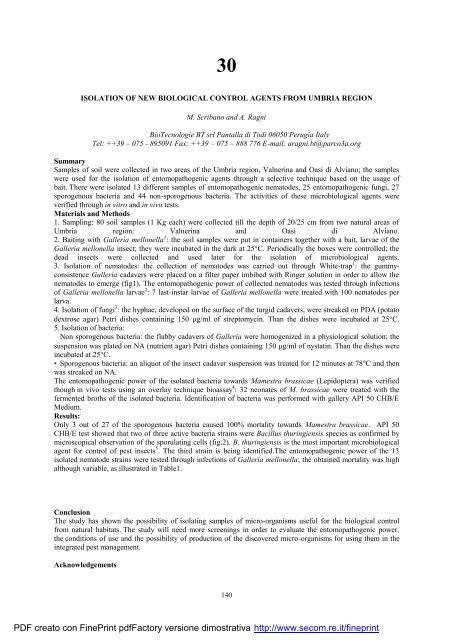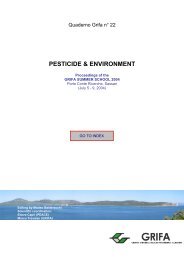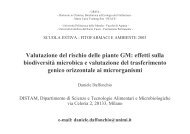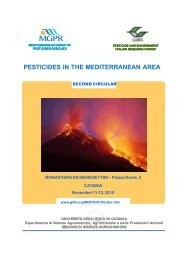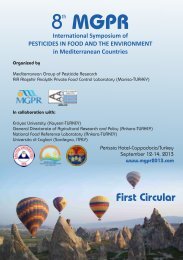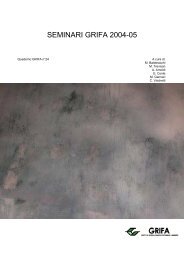International Congress BIOLOGICAL PRODUCTS - Gruppo di ...
International Congress BIOLOGICAL PRODUCTS - Gruppo di ...
International Congress BIOLOGICAL PRODUCTS - Gruppo di ...
You also want an ePaper? Increase the reach of your titles
YUMPU automatically turns print PDFs into web optimized ePapers that Google loves.
30<br />
ISOLATION OF NEW <strong>BIOLOGICAL</strong> CONTROL AGENTS FROM UMBRIA REGION<br />
M. Scribano and A. Ragni<br />
BioTecnologie BT srl Pantalla <strong>di</strong> To<strong>di</strong> 06050 Perugia Italy<br />
Tel: ++39 – 075 - 895091 Fax: ++39 – 075 – 888 776 E-mail: aragni.bt@parco3a.org<br />
Summary<br />
Samples of soil were collected in two areas of the Umbria region, Valnerina and Oasi <strong>di</strong> Alviano; the samples<br />
were used for the isolation of entomopathogenic agents through a selective technique based on the usage of<br />
bait. There were isolated 13 <strong>di</strong>fferent samples of entomopathogenic nematodes, 25 entomopathogenic fungi, 27<br />
sporogenous bacteria and 44 non-sporogenous bacteria. The activities of these microbiological agents were<br />
verified through in vitro and in vivo tests.<br />
Materials and Methods<br />
1. Sampling: 80 soil samples (1 Kg each) were collected till the depth of 20/25 cm from two natural areas of<br />
Umbria region: Valnerina and Oasi <strong>di</strong> Alviano.<br />
2. Baiting with Galleria mellonella 1 : the soil samples were put in containers together with a bait, larvae of the<br />
Galleria mellonella insect; they were incubated in the dark at 25°C. Perio<strong>di</strong>cally the boxes were controlled; the<br />
dead insects were collected and used later for the isolation of microbiological agents.<br />
3. Isolation of nematodes: the collection of nematodes was carried out through White-trap 1 : the gummyconsistence<br />
Galleria cadavers were placed on a filter paper imbibed with Ringer solution in order to allow the<br />
nematodes to emerge (fig1). The entomopathogenic power of collected nematodes was tested through infections<br />
of Galleria mellonella larvae 2 : 7 last-instar larvae of Galleria mellonella were treated with 100 nematodes per<br />
larva.<br />
4. Isolation of fungi 3 : the hyphae, developed on the surface of the turgid cadavers, were streaked on PDA (potato<br />
dextrose agar) Petri <strong>di</strong>shes containing 150 µg/ml of streptomycin. Than the <strong>di</strong>shes were incubated at 25°C.<br />
5. Isolation of bacteria:<br />
Non sporogenous bacteria: the flabby cadavers of Galleria were homogenized in a physiological solution; the<br />
suspension was plated on NA (nutrient agar) Petri <strong>di</strong>shes containing 150 µg/ml of nystatin. Than the <strong>di</strong>shes were<br />
incubated at 25°C.<br />
Sporogenous bacteria: an aliquot of the insect cadaver suspension was treated for 12 minutes at 78°C and then<br />
was streaked on NA.<br />
The entomopathogenic power of the isolated bacteria towards Mamestra brassicae (Lepidoptera) was verified<br />
though in vivo tests using an overlay technique bioassay 4 : 32 neonates of M. brassicae were treated with the<br />
fermented broths of the isolated bacteria. Identification of bacteria was performed with gallery API 50 CHB/E<br />
Me<strong>di</strong>um.<br />
Results:<br />
Only 3 out of 27 of the sporogenous bacteria caused 100% mortality towards Mamestra brassicae. API 50<br />
CHB/E test showed that two of three active bacteria strains were Bacillus thuringiensis species as confirmed by<br />
microscopical observation of the sporulating cells (fig.2). B. thuringiensis is the most important microbiological<br />
agent for control of pest insects 5 . The third strain is being identified.The entomopathogenic power of the 13<br />
isolated nematode strains were tested through infections of Galleria mellonella; the obtained mortality was high<br />
although variable, as illustrated in Table1.<br />
Conclusion<br />
The study has shown the possibility of isolating samples of micro-organisms useful for the biological control<br />
from natural habitats. The study will need more screenings in order to evaluate the entomopathogenic power,<br />
the con<strong>di</strong>tions of use and the possibility of production of the <strong>di</strong>scovered micro-organisms for using them in the<br />
integrated pest management.<br />
Acknowledgements<br />
PDF creato con FinePrint pdfFactory versione <strong>di</strong>mostrativa http://www.secom.re.it/fineprint<br />
140


